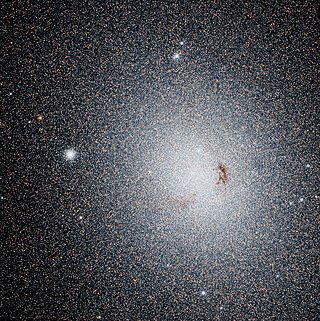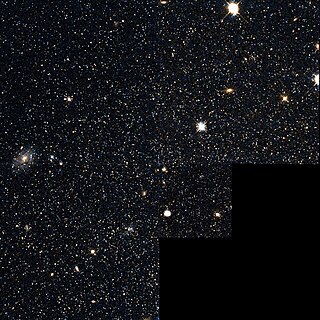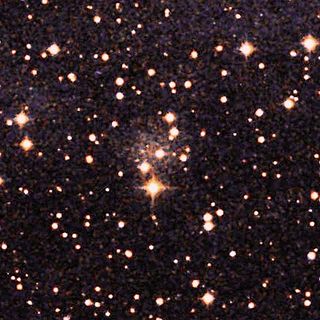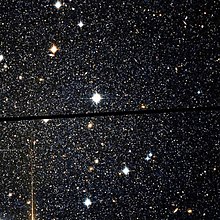
The Local Group is the galaxy group that includes the Milky Way. It has a total diameter of roughly 3 megaparsecs (10 million light-years; 9×1019 kilometres), and a total mass of the order of 2×1012 solar masses (4×1042 kg). It consists of two collections of galaxies in a "dumbbell" shape; the Milky Way and its satellites form one lobe, and the Andromeda Galaxy and its satellites constitute the other. The two collections are separated by about 800 kiloparsecs (3×10^6 ly; 2×1019 km) and are moving toward one another with a velocity of 123 km/s. The group itself is a part of the larger Virgo Supercluster, which may be a part of the Laniakea Supercluster. The exact number of galaxies in the Local Group is unknown as some are occluded by the Milky Way; however, at least 80 members are known, most of which are dwarf galaxies.

The Andromeda Galaxy is a barred spiral galaxy and is the nearest major galaxy to the Milky Way, where the Solar System resides. It was originally named the Andromeda Nebula and is cataloged as Messier 31, M31, and NGC 224. Andromeda has a diameter of about 46.56 kiloparsecs and is approximately 765 kpc from Earth. The galaxy's name stems from the area of Earth's sky in which it appears, the constellation of Andromeda, which itself is named after the princess who was the wife of Perseus in Greek mythology.

The Pegasus Dwarf Spheroidal is a dwarf spheroidal galaxy about 2.7 million light-years away in the constellation Pegasus. The Pegasus Dwarf is a member of the Local Group and a satellite galaxy of the Andromeda Galaxy (M31).

NGC 404 is a field galaxy located about 10 million light years away in the constellation Andromeda. It was discovered by William Herschel in 1784, and is visible through small telescopes. NGC 404 lies just beyond the Local Group and does not appear gravitationally bound to it. It is located within 7 arc-minutes of second magnitude star Mirach, making it a difficult target to observe or photograph and granting it the nickname "Mirach's Ghost".

NGC 185 is a dwarf spheroidal galaxy located 2.08 million light-years from Earth, appearing in the constellation Cassiopeia. It is a member of the Local Group, and is a satellite of the Andromeda Galaxy (M31). NGC 185 was discovered by William Herschel on November 30, 1787, and he cataloged it "H II.707". John Herschel observed the object again in 1833 when he cataloged it as "h 35", and then in 1864 when he cataloged it as "GC 90" within his General Catalogue of Nebulae and Clusters. NGC 185 was first photographed between 1898 and 1900 by James Edward Keeler with the Crossley Reflector of Lick Observatory. Unlike most dwarf elliptical galaxies, NGC 185 contains young stellar clusters, and star formation proceeded at a low rate until the recent past. NGC 185 has an active galactic nucleus (AGN) and is usually classified as a type 2 Seyfert galaxy, though its status as a Seyfert is questioned. It is possibly the closest Seyfert galaxy to Earth, and is the only known Seyfert in the Local Group.

A dwarf spheroidal galaxy (dSph) is a term in astronomy applied to small, low-luminosity galaxies with very little dust and an older stellar population. They are found in the Local Group as companions to the Milky Way and to systems that are companions to the Andromeda Galaxy (M31). While similar to dwarf elliptical galaxies in appearance and properties such as little to no gas or dust or recent star formation, they are approximately spheroidal in shape and generally have lower luminosity.

Andromeda I is a dwarf spheroidal galaxy (dSph) about 2.40 million light-years away in the constellation Andromeda. Andromeda I is part of the local group of galaxies and a satellite galaxy of the Andromeda Galaxy (M31). It is roughly 3.5 degrees south and slightly east of M31. As of 2005, it is the closest known dSph companion to M31 at an estimated projected distance of ~40 kpc or ~150,000 light-years.

The Sculptor Dwarf Galaxy is a dwarf spheroidal galaxy that is a satellite of the Milky Way. The galaxy lies within the constellation Sculptor. It was discovered in 1937 by American astronomer Harlow Shapley using the 24-inch Bruce refractor at Boyden Observatory. The galaxy is located about 290,000 light-years away from the Solar System. The Sculptor Dwarf contains only 4 percent of the carbon and other heavy elements in our own galaxy, the Milky Way, making it similar to primitive galaxies seen at the edge of the universe.
The Milky Way has several smaller galaxies gravitationally bound to it, as part of the Milky Way subgroup, which is part of the local galaxy cluster, the Local Group.
Andromeda III is a dwarf spheroidal galaxy about 2.44 million light-years away in the constellation Andromeda. It is part of the Local Group and is a satellite galaxy of the Andromeda Galaxy (M31). The galaxy was discovered by Sidney van den Bergh on photographic plates taken in 1970 and 1971.
Andromeda V is a dwarf spheroidal galaxy about 2.52 Mly away in the constellation Andromeda.

The Cassiopeia Dwarf (also known as Andromeda VII) is a dwarf spheroidal galaxy about 2.45 Mly away in the constellation Cassiopeia. The Cassiopeia Dwarf is part of the Local Group and a satellite galaxy of the Andromeda Galaxy (M31). In the sky, it appears behind the Milky Way's galactic plane, and so it is reddened by 0.194 magnitudes. With a luminosity of 1.8×107 L☉ and a stellar mass of 19.73×106 M☉, it is the brightest and most massive of the Andromeda Galaxy's dwarf spheroidal galaxy satellites. It also has the highest metallicity out of all of them.
Pisces II is a dwarf spheroidal galaxy situated in the Pisces constellation and discovered in 2010 in the data obtained by the Sloan Digital Sky Survey. The galaxy is located at the distance of about 180 kpc (kiloparsecs) from the Sun. It is classified as a dwarf spheroidal galaxy (dSph) meaning that it has an elongated shape with the half-light radius of about 60 pc and ratio of the axis of about 5:3.
Andromeda XXI is a moderately bright dwarf spheroidal galaxy about 859 ± 51 kiloparsecs (2.80 ± 0.17 Mly) away from the Sun in the constellation Andromeda. It is the fourth largest Local Group dwarf spheroidal galaxy. The discovery arose from the first year data of a photometric survey of the M31/M33 subgroupings of the Local Group by the Pan-Andromeda Archaeological Survey (PAndAS). This survey was conducted with the Megaprime/MegaCam wide-field camera mounted on the Canada-France-Hawaii Telescope.
Andromeda XXII is a low surface brightness dwarf spheroidal galaxy about 940–1,033 kiloparsecs away from the Sun in the constellation Pisces, of the Local Group.
Andromeda XIX is a satellite galaxy of the Andromeda Galaxy (M31), a member of the Local Group, like the Milky Way Galaxy. Andromeda XIX is considered "the most extended dwarf galaxy known in the Local Group", and has been shown to have a half-light radius of 1.7 kiloparsec (kpc). It was discovered by the Canada–France–Hawaii Telescope, and is thought to be a dwarf galaxy.

Andromeda XVIII, discovered in 2008, is a dwarf spheroidal galaxy, which is a satellite of the Andromeda Galaxy (M31). It is one of the 14 known dwarf galaxies orbiting M31. It was announced in 2010 that the orbiting galaxies lie close to a plane running through M31's center.












